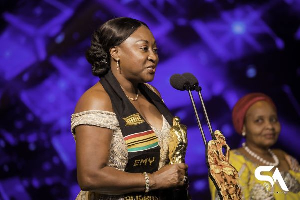Opinions of Tuesday, 13 October 2020
Columnist: Paul C Adjei
Is Ghana ready for a female President or Vice President?
The collective answer? Yes! Ghana is ready for a female president or vice-president!!!
And all Ghanaians regardless of political affiliation must reward the National Democratic Congress for making history by keeping faith with the women and girls of Ghana.
Sadly, the increasing proportion of females in leadership ranks all over the world has led paradoxically to these kinds of questions where females need to continuously prove themselves as leaders or would-be leaders.
Thankfully though, in our context, look no further for proof that the answer to the above question should not even be up for debate: women have proved themselves at all levels in our society – at the lowest levels in the trenches at home, in the smoky kitchens and on dry farmlands in poor villages; at the highest levels on the Supreme Court, the National Reconciliation Commission, the Commission on Human Rights and Administrative Justice and the National Electoral Commission; It took a woman to galvanize the men of the Ashanti kingdom into action! It took a woman to lead Liberia out of its civil war and another woman (from Ghana) to organize and lead its first post-war democratic elections!
In the current global pandemic of SAR-COV-2, it is no coincidence that countries like New Zealand, Taiwan and Germany, which are led by female Presidents/Prime Ministers have been the best performing ones, having gotten it right from day one.
Even in countries with male Heads of State, the First Ladies have been known to be the movers and shakers behind the scenes – the backbones of their husbands winning and/or maintenance of power. In this regard, Nana Konadu Agyemang-Rawlings’ extensive mobilization outreach through the December 31st Women’s Movement comes readily to mind; Winnie Mandela in South Africa; Michelle Obama, Hillary Clinton, Barbara Bush, Nancy Reagan, Lady Bird Johnson (wife of Lyndon B. Johnson, the President who signed the Civil Rights Act into existence) and Eleanor Roosevelt all of the USA come to mind as the backbones “behind every successful man” in those contexts.
Is it by sheer coincidence that The British monarchy, credited as one of the most successful and consequential in history, is also the one in which females have been prominently represented? Queens Victoria, Elizabeth I and Elizabeth II, all of England and Mary Queen of Scotland. Compared to the male monarchs of Great Britain, Queen Elizabeth II is not only one of the longest reigning, but also holds the most special place in history in her handling of post-colonial Britain, and now post-Brexit fallouts. She has ensured that Britain retained all of its influence in the post-colonial world and especially over its former colonies through the formation of an almost neo-colonialist organization known as the Commonwealth of Nations.
Go back further into ancient history and you will find the Queen of Sheba and Cleopatra of Egypt. These iron-willed female rulers ensured not only their own survival in those times of barbaric male dominance, but those of their “Queendoms” by forging great alliances and ultimately “out-surviving” the greatest emperors of their times – Solomon of Israel and Julius Caesar-Mark Anthony of the great Roman Empire. These Queens did what was acceptable in their days to ensure the prosperity of their lands. What more could you expect from a competent leader?
A comprehensive definition of leadership is that of a process in which an individual influences a group of individuals to achieve a common goal (Northouse, 2004). According to Gardner (1995), “The greatest challenge leaders face is to bring about significant and lasting changes in a large and heterogeneous group”.
Leadership style involves two clearly independent dimensions: the task dimension that includes goal setting, organization, direction, and control; and the relationship dimension involving support, communication, interaction, and active listening (Hersey and Blanchard, 1988).
Historically, men have been perceived as being better suited to become leaders than women. Traditional gender stereotypes (nothing to do with competence or lack thereof) are a major reason for the negative perception of female leaders.
Several studies have indicated a stereotype of the “typical” man and woman across groups differing in sex, age, marital status, and education (Neubert and Taggar, 2004). This facilitates the argument that male gender qualities are oriented towards more impersonal, task-oriented or transactional approach to leadership, while female gender qualities tend towards a more nurturing, relationships-oriented style of leadership that underlies their transformational leadership approach (Pounder and Coleman, 2002).
Indeed, there is research suggesting that when women do occupy leadership positions, they display different leadership styles that are non-inferior and, in some cases, superior compared to males. A literature review on female leadership, (Eagly and Johnson, 1990, Eagly and Carli 2003) concluded that among managers, women tended to be more democratic in their leadership styles while men showed a more autocratic leadership style.
They also reported that a meta-analysis of 45 studies examining gender differences in transformational leadership behaviours found that compared to male leaders, female leaders used a more transformational style. Research findings of Trinidad and Normore (2005) also show that women adopt democratic and participative leadership styles in the corporate world and in education. Being a female has been significantly associated with transformational and motivational leadership in many different settings, both formal and informal.
Indeed, it has been theorized (Helgesen 1990, Pounder and Coleman 2002), that men and women manage in sharply different ways, that women naturally form centre-archives, namely organizations with the leader at the centre, not on top. Women’s central involvement in managing households, raising children and juggling careers give them a capacity for prioritization in a leadership role that men typically do not possess or did not need to. This makes the female approach superior in developing countries where prioritization of societal development is a key challenge.
Thus, we have gone with society’s stereotype of females as “insecure, over-controlling and unable to engage in team play behaviour” (Madden, 1987) and come back full circle to society’s new stereotype of female leaders as “relationship-oriented, non-hierarchical and interested in sharing power and information (Helgesen, 1990; Rosener, 1990). What was once labelled as women’s weaknesses and cited as reasons for them being ill-suited for top jobs, are currently the very traits male executives are expected to possess (Fireman, 1990).
The point must be made though that female leadership styles are not necessarily better (or worse) than the traditional male-oriented ones, they are just different and more suited to our specific situation as a developing country – with significant gender and socioeconomic gaps – that has more or less stagnated under male leadership since Independence.
So, in conclusion, my question and answer to the question – Is Ghana ready for a female president or vice-president? – is: you tell me why not???














